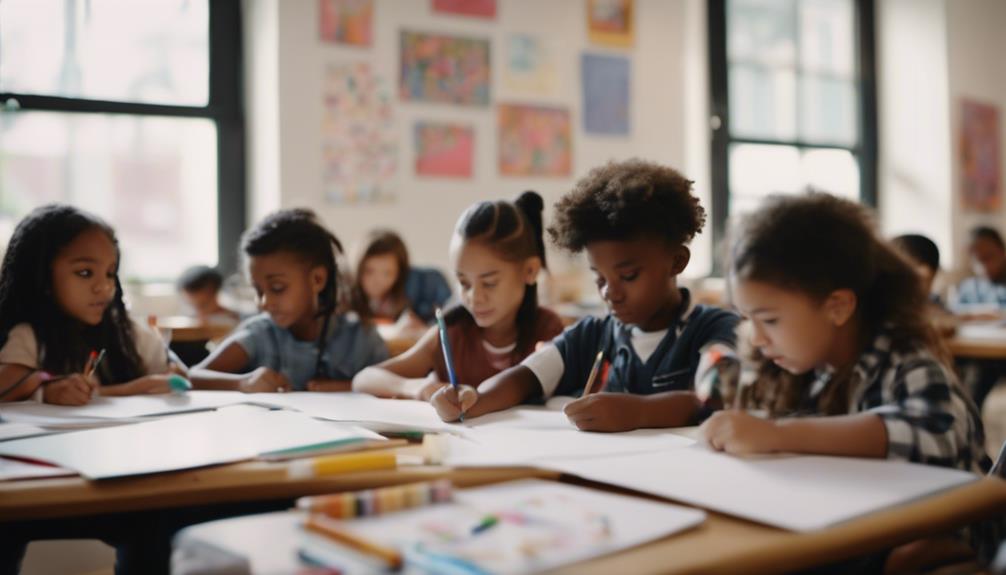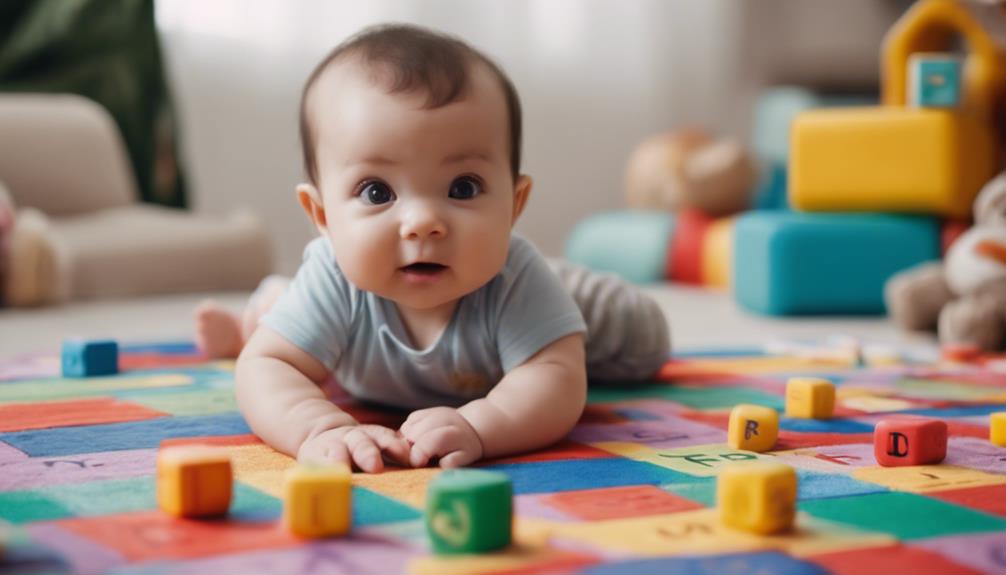To kickstart pre-reading skills, try engaging your toddler with fun activities like a colorful alphabet treasure hunt, where they search for letter objects around the house or yard. Incorporate sensory play with letter tracing using materials like sand or playdough, and sing lively alphabet songs to reinforce sounds and recognition. Use puzzles, matching games, and craft activities to make learning interactive and enjoyable. Keep exploring these ideas, and you’ll discover even more ways to support your child’s early literacy journey.
Key Takeaways
- Incorporate hands-on activities like puzzles, playdough letters, and matching games to develop letter recognition and fine motor skills.
- Use sensory-rich experiences such as tactile tracing and sensory bins to reinforce letter shapes and sounds.
- Engage toddlers with musical alphabet songs and movement-based activities to enhance auditory skills and physical coordination.
- Utilize colorful alphabet books and visual aids to promote early recognition and understanding of letter forms.
- Practice repetition with songs, rhymes, and digital resources to build confidence and solidify pre-reading foundations.
Colorful Alphabet Treasure Hunt

A colorful alphabet treasure hunt is a fun way to help toddlers learn their letters while getting them moving. This activity boosts toddler engagement by transforming learning into an exciting game. You can hide alphabet cards or objects representing different letters around a room or yard. As your child searches for these items, they’ll naturally recognize and recall letter shapes. Incorporate alphabet activities by encouraging your toddler to find specific letters or sort items by letter. Keep the game lively and interactive to maintain their interest. This hands-on approach makes learning memorable and enjoyable, helping your little one develop early letter recognition skills. Plus, it’s a great way to combine physical activity with educational fun, setting a positive tone for future reading adventures.
Letter Tracing With Sensory Materials

Using sensory materials for letter tracing makes learning engaging and tactile for toddlers. When you incorporate tactile tracing, you help your child develop proper letter formation by allowing them to feel the shapes of letters with their fingers. Materials like sand, rice, or clay provide a hands-on experience that reinforces letter recognition and motor skills. As your toddler traces each letter, they connect the physical movement with the visual shape, strengthening neural pathways for reading readiness. This activity encourages focus, improves fine motor control, and makes the learning process fun. By integrating sensory materials into letter tracing, you create a multi-sensory environment that supports early literacy development and helps your child build confidence in their ability to write and recognize letters. Additionally, fostering creativity in the digital age can inspire your child to explore new ways of expressing themselves through art and storytelling. Incorporating multisensory learning techniques further enhances their engagement and memory retention during this foundational skill-building.
Sing-Along Alphabet Songs and Rhymes
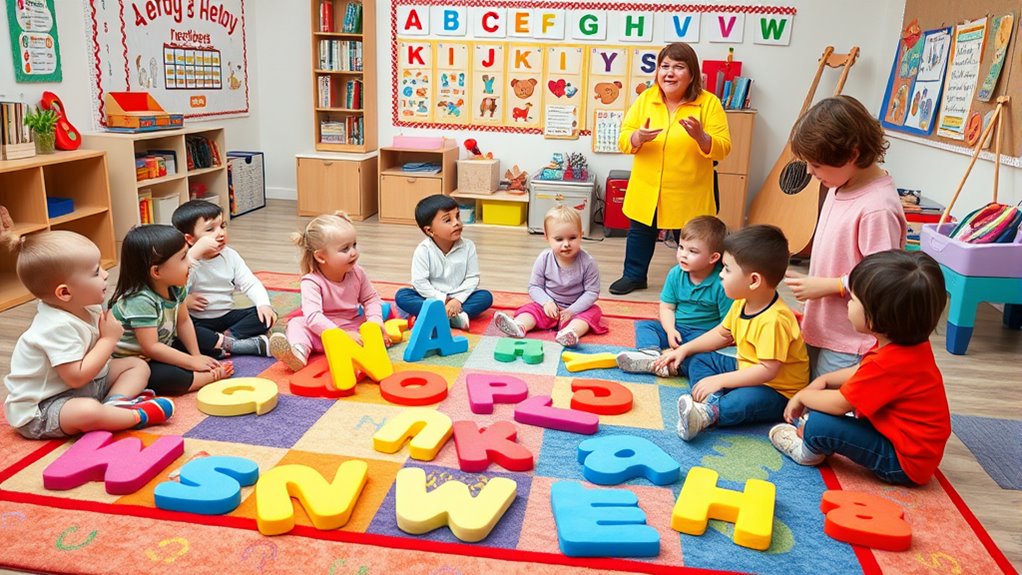
Sing-along alphabet songs with engaging tunes make learning fun and memorable. The rhythmic movement in these songs helps your toddler connect sounds with actions, boosting their coordination. Repetition of these rhymes reinforces letter recognition and builds confidence in their learning journey. Incorporating auditory cues enhances their ability to associate sounds with letters, further supporting early literacy skills. Additionally, understanding the importance of credit card literacy can help parents teach children about financial concepts early on, fostering responsible habits from a young age. Incorporating sound therapy techniques into your child’s routine can also promote relaxation and focus, complementing their early learning experiences. Recognizing the significance of Private Placement Memorandum concepts can provide parents with insights into structured financial education for future planning. For example, implementing sound early childhood education practices can optimize your child’s developmental progress.
Engaging Song Selections
Engaging song selections can make learning the alphabet fun and memorable for toddlers. When you choose lively, catchy tunes, you encourage music integration, which boosts memory and engagement. To enhance the experience, try these tips:
- Use familiar melodies like “Twinkle, Twinkle, Little Star” with added alphabet verses.
- Incorporate storytelling techniques by creating simple stories around each letter to spark imagination.
- Sing along regularly, encouraging your child to participate actively and build confidence.
- Incorporating alphabet songs into your routine can reinforce letter recognition and make learning more enjoyable. Using songs that include antioxidants and vitamins can also promote overall health awareness indirectly related to learning environments.
- Selecting songs with repetition and rhythm can help reinforce memory and aid in learning letters more effectively. These strategies make learning feel like play, helping your toddler connect sounds with letters effortlessly. Additionally, integrating music therapy principles can further enhance engagement and retention during learning activities. Songs with repetition and storytelling not only entertain but also reinforce letter recognition, making pre-reading skills a natural part of your child’s daily routine.
Rhythmic Movement Benefits
Incorporating rhythmic movement into alphabet songs and rhymes can considerably enhance a toddler’s learning experience. When you encourage your child to move along with the music, it boosts their movement coordination, helping them develop better control over their body. These movements also promote spatial awareness, as they learn to navigate their space while performing actions like clapping, stomping, or swaying. Rhythmic activities make learning more engaging and memorable, reinforcing letter recognition through physical involvement. As your toddler moves to the beat, they connect sounds with actions, strengthening neural pathways for early literacy skills. This active participation fosters confidence and helps them enjoy the process of learning the alphabet in a fun, dynamic way.
Repetition Enhances Learning
Repetition plays a pivotal role in helping toddlers learn the alphabet, as hearing and singing the same songs multiple times reinforces memory and recognition. When you introduce sing-along alphabet songs and rhymes regularly, repetition improves retention and makes learning feel natural. Plus, reinforcement builds confidence, encouraging your child to participate more actively. To maximize these benefits, try:
- Repeating songs daily to strengthen memory.
- Using different tunes or rhymes to keep it engaging.
- Encouraging your toddler to sing along, boosting their confidence.
- Incorporating digital resources that support digital literacy development in early education.
- Understanding how automation in education can personalize learning experiences for better outcomes.
- Incorporating multisensory activities can help reinforce letter recognition through touch, sight, and sound, making learning more engaging.
Consistent repetition helps your child recognize letters quickly and makes the learning process enjoyable. Additionally, integrating artificial intelligence tools in early education can adapt lessons to your child’s individual learning pace, further enhancing their progress. Over time, this steady reinforcement supports their pre-reading skills and builds a solid foundation for future literacy.
Alphabet Puzzle Playtime
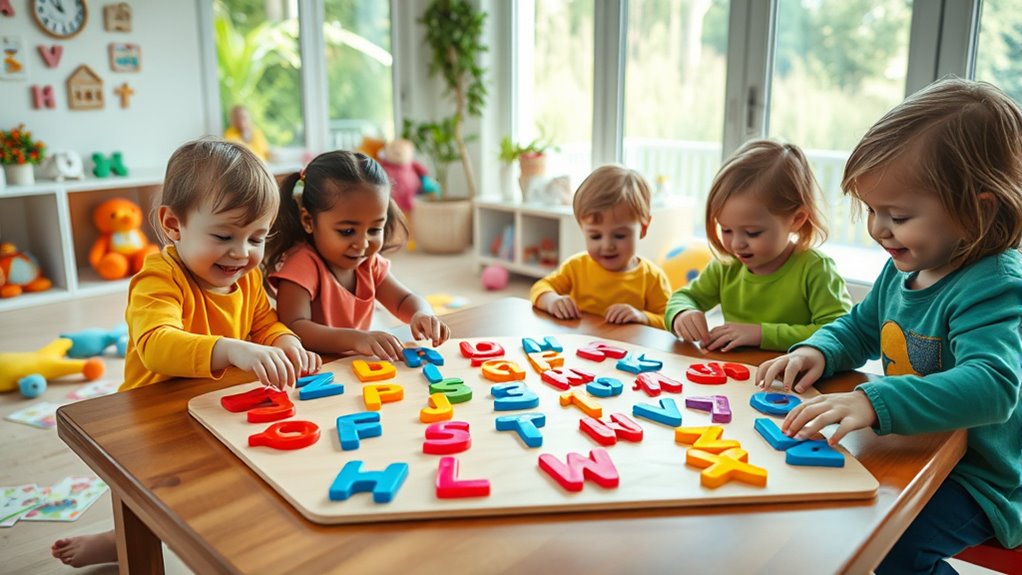
Alphabet puzzle playtime offers a fun and interactive way for toddlers to learn their letters. As you introduce alphabet puzzles, your child develops essential letter recognition skills while engaging in hands-on activity. These puzzles typically feature pieces shaped like individual letters that fit into a corresponding board, helping your toddler connect visual shapes with their sounds. During play, encourage your child to identify each letter and place it correctly, reinforcing their understanding of the alphabet. This activity boosts confidence and makes learning enjoyable. Plus, it promotes fine motor skills as they grasp and fit puzzle pieces. Keep the sessions relaxed and praise their efforts to foster a positive attitude toward learning. Alphabet puzzle playtime is a simple yet effective step in building a strong pre-reading foundation.
Crafting Letters With Playdough and Materials

Creating letters with playdough and simple materials offers a fun way to engage your toddler’s senses. This activity enhances their fine motor skills and encourages letter recognition through hands-on play. Plus, you can use easy-to-find items like cookie cutters, straws, or household objects to keep it simple and enjoyable. Incorporating letter formation techniques can further support your child’s early writing skills. Engaging in such creative activities can also help foster a positive attitude towards learning and parent-child bonding. Exploring hackathons in the context of educational innovation can inspire new ways to incorporate technology into early childhood activities. Understanding prenatal development can provide insights into how early childhood experiences shape learning behaviors. Additionally, selecting age-appropriate materials ensures safety and maximizes developmental benefits.
Sensory Play Benefits
Have you ever noticed how shaping letters with playdough and other textured materials can engage your toddler’s senses? This activity promotes tactile exploration and sensory integration, which are vital for early development. When your child manipulates different textures, they strengthen fine motor skills and improve hand-eye coordination. Here are some benefits:
- Enhances tactile exploration by exposing your toddler to varied textures, boosting sensory awareness.
- Supports sensory integration, helping your child process and respond to sensory information effectively.
- Encourages fine motor development as they pinch, roll, and shape the materials into letters.
- Incorporating sensory play or similar tools into play can introduce children to concepts of energy and movement in a fun, age-appropriate way.
These activities not only make learning fun but also build essential skills needed for pre-reading. Using textured materials taps into their natural curiosity and sensory responses, making letter recognition a multi-sensory experience.
Easy Material Options
Using simple, everyday materials makes crafting letters with toddlers easy and enjoyable. Playdough, pipe cleaners, and foam sheets are accessible options that encourage letter recognition and reinforce alphabet sounds. As your child molds and shapes these materials, they actively engage with each letter’s form, helping solidify their understanding of letter shapes. Repeating this process with different letters helps strengthen their ability to recognize familiar shapes and associate them with corresponding sounds. These materials are soft, safe, and versatile, making cleanup simple. Plus, tactile play with familiar items boosts fine motor skills and keeps your toddler engaged. Incorporating these easy-to-find materials into activities creates a fun, effective way to kickstart their pre-reading journey.
Alphabet Book Exploration Activities

Exploring alphabet books with your toddler is a fun and engaging way to introduce letter recognition and early literacy skills. When selecting books, consider their design—bright pictures, clear fonts, and interactive features make learning enjoyable. You can focus on:
- Comparing phonics vs. alphabet recognition—some books emphasize sounds, while others highlight letter shapes, helping your child understand different aspects of reading.
- Pointing out how alphabet book design influences learning—look for books that combine visuals with simple text to reinforce letter identification.
- Encouraging your toddler to trace letters or repeat sounds, making the experience more interactive and reinforcing early skills.
Letter Matching Games and Activities
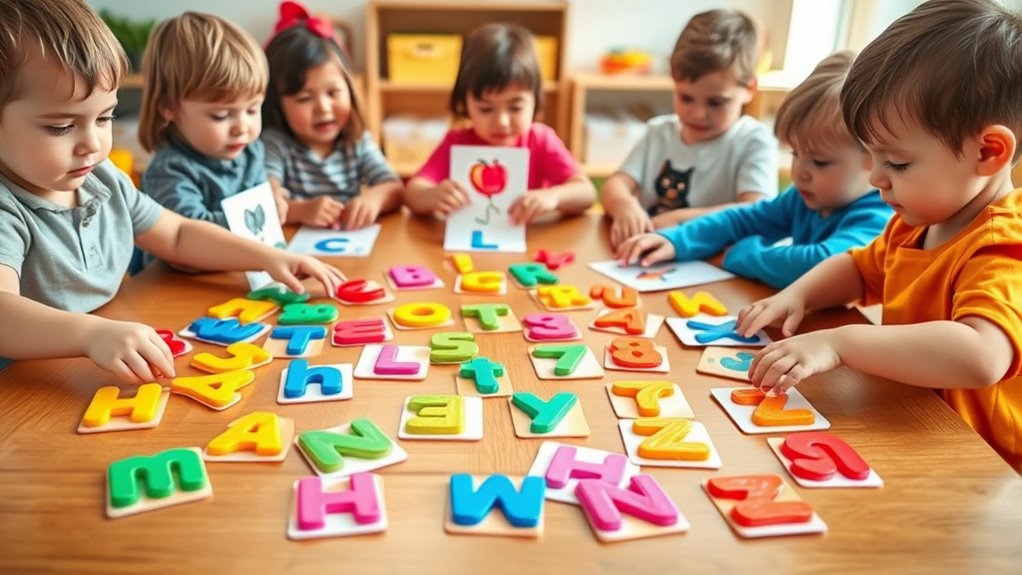
Letter matching games are a fantastic way to strengthen your toddler’s recognition of alphabet shapes and sounds. These activities help reinforce letter recognition by encouraging your child to identify and match uppercase and lowercase letters. You can use foam letters, flashcards, or even magnetic letters on the fridge for hands-on fun. As they become more confident, introduce simple alphabet sequencing activities, like arranging letters in order. This not only boosts their understanding of the alphabet but also builds early sequencing skills. Make the games playful and interactive, asking questions like, “Can you find the letter A?” or “What letter comes after B?” Consistent practice with these activities sets a solid foundation for your toddler’s pre-reading skills.
Creating an Alphabet Wall or Banner
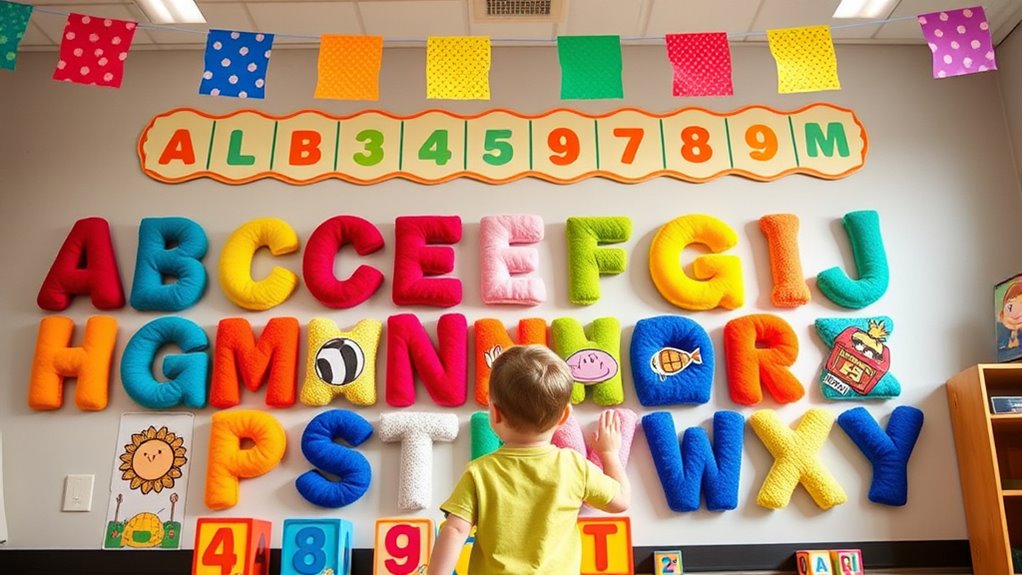
Creating an alphabet wall or banner is an engaging way to immerse your toddler in letter recognition. It transforms learning into a visual and interactive experience. To make it effective, consider these steps:
- Gather colorful, large letter cards or cutouts to catch your child’s attention.
- Encourage your toddler to place each letter on a designated space, helping build their fine motor skills as they peel, stick, or pin the letters.
- Use the wall or banner daily for quick letter recognition exercises, reinforcing their familiarity with the alphabet. This activity supports early literacy by making letter recognition fun and hands-on. Plus, it helps develop fine motor skills as your toddler manipulates the letters, preparing them for writing. Keep it simple, colorful, and interactive for maximum engagement.
Frequently Asked Questions
How Can I Adapt These Activities for Children With Special Needs?
To adapt activities for children with special needs, you should focus on individualized adaptations and inclusive strategies. You can modify materials, like using textured or larger objects, to suit their sensory needs. Incorporate visual aids, simplified instructions, and give extra time for engagement. By tailoring activities to each child’s abilities and preferences, you create an inclusive environment that promotes learning and confidence for all learners.
What Are Some Signs My Toddler Is Ready for Alphabet Activities?
Research suggests that early literacy cues can appear as signs of readiness in your toddler. Look for signs like interest in letters, attempts to mimic letter sounds, or recognizing familiar symbols. If your child shows curiosity about books, points to letters, or enjoys listening to stories, they’re likely ready for alphabet activities. These signs indicate they’re developing foundational skills that make engaging in pre-reading activities beneficial and enjoyable.
How Much Time Should Each Activity Ideally Last?
When planning activities, you should consider duration guidelines that suit your toddler’s attention span. Typically, each activity should last about 10 to 15 minutes, depending on their interest and energy levels. Keep activity timing flexible; if your child shows signs of boredom or fatigue, it’s best to switch to something else or take a break. Short, engaging sessions help maintain their enthusiasm and make learning enjoyable.
Are There Recommended Age Ranges for These Alphabet Activities?
Wondering if these activities fit your child’s age? You’ll want to take into account age appropriateness and developmental readiness. Typically, activities are designed for specific toddler stages, usually from 12 to 36 months. But every child develops uniquely. Watch for signs like attention span and motor skills to judge if an activity suits their current level. Tailoring activities ensures they stay engaged and benefit the most, setting a solid foundation for pre-reading skills.
How Can I Incorporate These Activities Into Daily Routines?
To incorporate these activities into your daily routine, you can integrate alphabet play during everyday moments. Use mealtime to point out letters on food packages or utensils, and sing alphabet songs while dressing or driving. Integrating alphabet activities with routines makes learning fun and natural. Follow daily routine tips like short, consistent sessions, involving your child in simple tasks, and keeping activities engaging to foster early literacy skills effortlessly.
Conclusion
Now that you have these fun alphabet activities, you’re well on your way to planting the seeds of reading in your toddler’s mind. Keep things lively and engaging, and remember, patience is key—little hands and minds need time to grow. With your dedication, you’ll turn learning into a colorful adventure where every moment is a stepping stone. Before you know it, those tiny explorers will be climbing the ladder to literacy with confidence and joy.


